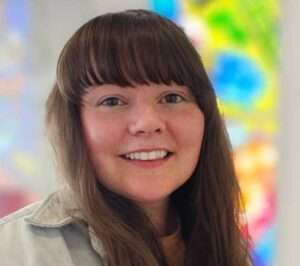
Jorda Kovash is one of two Alaska-based graduate students who received the prestigious National Science Foundation Graduate Research Fellowship in the 2024 cycle.
University of Alaska Fairbanks graduate student Jorda Kovash was recently awarded a National Science Foundation Graduate Research Fellowship. She is one of two graduate students in the state of Alaska who received the prestigious award in the 2024 cycle.
In addition to professional development opportunities, the fellowship provides three years of financial support, including an annual stipend of $37,000 and $16,000 to cover the cost of tuition.
Kovash studies in the Department of Biology and Wildlife under the auspices of the Institute of Arctic Biology. Since 2015, she has been researching how the immune systems of trembling aspens respond to a fungal disease called aspen running canker. She sequences the RNA of infected trees — a novel approach because RNA sequencing is traditionally used to study human cell biology, not flora.
“This is an emerging pathogen in the sub-Arctic,” said Kovash. “RNA sequencing has very rarely, if ever, been used as a tool to look at forest health.”
Trembling aspens are one of four deciduous tree species in the boreal forest. They are an important food source for moose. They also serve as natural firebreaks during fire season, making Kovash’s research timely in the face of climate change. According to the USDA Climate Hubs website, changes in the Interior’s climate are forecast to increase fire frequency and intensity.
“Jorda has already made significant contributions to this research, and I am excited to see what she discovers with the help of this fellowship in the next few years,” said research scientist Ursel Schütte, one of Kovash’s advisors and a co-principal investigator on the project. “It’s exciting for such a deserving student to be recognized by the NSF.”
Kovash received undergraduate research support from UAF’s Biomedical Learning and Student Training program and the Alaska IDeA Network of Biomedical Research Excellence.
She is currently a master’s student, but her research with Schütte’s lab will most likely carry her through to her Ph.D.
“I think it’s so important to champion nontraditional students like Jorda,” said Mary Beth Leigh, co-principal investigator on the project and Kovash’s co-advisor. “She’s a first-generation college student who has pursued her passion for biology, natural resources and conservation in Montana, New York City and Alaska. She’s also worked in the service industry, as well as in disaster response. She’s incredibly mature as a researcher by having those diverse experiences.”
Kovash’s passion for her research is also deeply rooted in her cultural connection to the Mandan Tribe of the Great Plains.
She said, “I want to remain an environmental steward as a modern Native. It was a large part of my application for this fellowship — my journey, my connection to the land, and my dedication to linking the science with indigenous forms of knowledge.”
The NSF Graduate Research Fellowship Program began funding graduate research in 1952 and is the country’s oldest fellowship program directly supporting graduate students in myriad STEM fields, according to the NSF website. Since 1952, NSF has funded over 70,000 fellowships out of more than 500,000 applicants. Forty-two fellows have gone on to become Nobel laureates, and more than 450 have become members of the National Academy of Sciences.
